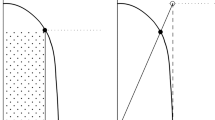Abstract
Convex cooperative games were first introduced by Shapley (Int J Game Theory 1:11–26, 1971) while population monotonic allocation schemes (PMAS) were subsequently proposed by Sprumont (Games Econ Behav 2:378–394, 1990). In this paper we provide several characterizations of convex games and introduce three new notions: PMAS-extendability, PMAS-exactness, and population monotonic set schemes, which imitate the classical concepts that they extend. We show that all of these notions provide new characterizations of the convexity of the game.
Similar content being viewed by others
References
Biswas AK, Parthasarathy T, Potters JAM, Voorneveld M (1999) Large cores and exactness. Games Econ Behav 28:1–12
Çiftçi B, Borm P, Hamers H (2010) Population monotonic path schemes for simple games. Theory Decis 69(2):205–218
Hendrickx R, Borm P, Timmer J (2002) A note on NTU convexity. Int J Game Theory 31:29–37
Ichiishi T (1981) Super-modularity: applications to convex games and to the greedy algorithm for LP. J Econ Theory 25:283–286
Izquierdo JM, Rafels C (2012) A characterization of convex TU games by means of the Mas-Colell bargaining set (à la Shimomura). Int J Game Theory 41:381–395
Kikuta K, Shapley L (1986) Core stability in n-person games. Unpublished manuscript
Moulin H (1990) Cores and large cores when population varies. Int J Game Theory 19:219–232
Peleg B, Sudhölter P (2007) Introduction to the theory of cooperative games, 2nd edn. Springer, Berlin
Schmeidler D (1972) Cores of exact games. J Math Anal Appl 40:214–225
Shapley L (1953) A value for n-person games. In: Kuhn H, Tucker A (eds) Contributions to the theory of games II. Princeton University Press, Princeton, pp 307–317
Shapley L (1971) Cores of convex games. Int J Game Theory 1:11–26
Sharkey WW (1982) Cooperative games with large cores. Int J Game Theory 11:175–182
Sprumont Y (1990) Population monotonic allocation schemes for cooperative games with transferable utility. Games Econ Behav 2:378–394
van Gellekom JRG, Potters JAM, Reijnierse JH (1999) Prosperity properties of TU-games. Int J Game Theory 28:211–227
Acknowledgments
We thank J. M. Izquierdo, J. Martínez de Albéniz and M. Núñez for their valuable comments. Institutional support from the Ministerio de Ciencia e Innovación and FEDER under grant ECO2011-22765, and from the Generalitat de Catalunya under grant 2009SGR0960 is acknowledged.
Author information
Authors and Affiliations
Corresponding author
Rights and permissions
About this article
Cite this article
Getán, J., Montes, J. & Rafels, C. A note: characterizations of convex games by means of population monotonic allocation schemes. Int J Game Theory 43, 871–879 (2014). https://doi.org/10.1007/s00182-013-0408-4
Accepted:
Published:
Issue Date:
DOI: https://doi.org/10.1007/s00182-013-0408-4




